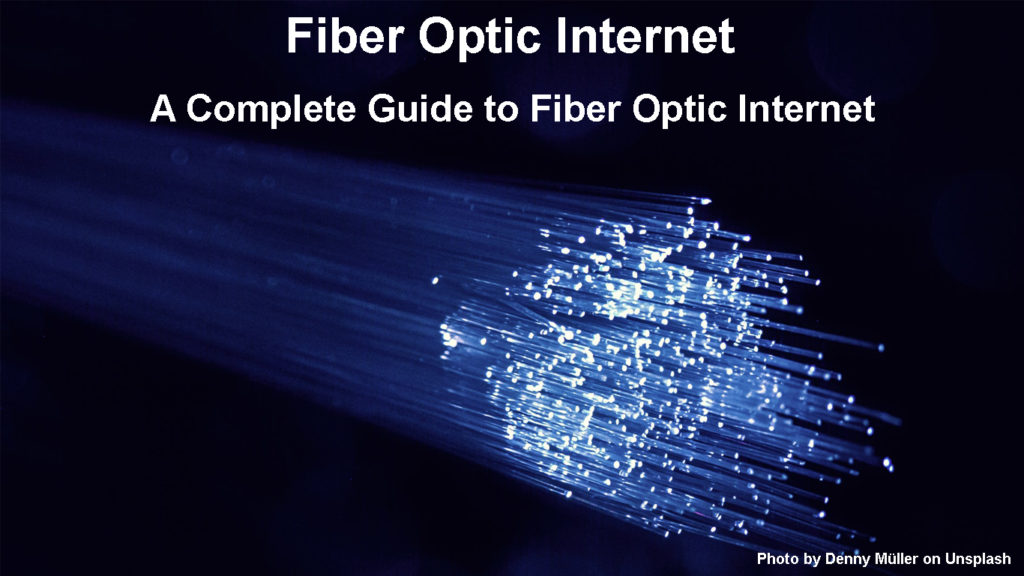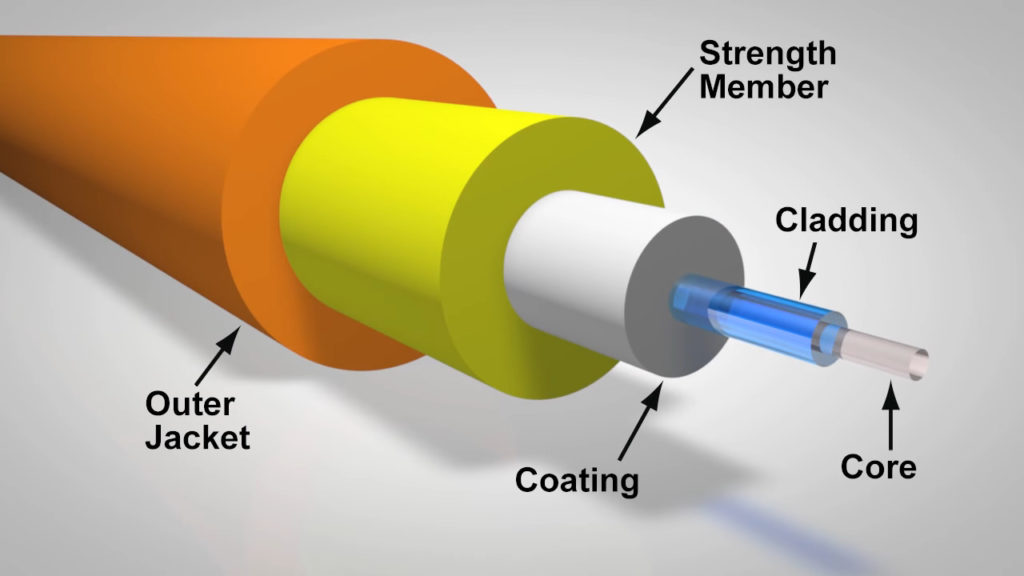A reliable internet connection is essential, whether at home or office. If you have ever looked for a better alternative to your current internet connection, fiber optic internet has come up. It is a better alternative to the traditional cable internet that we are used to.
Unfortunately, many people do not understand fiber optic internet, and finding a direct and elaborate explanation is difficult. Luckily you will find all the information concerning fiber internet in this post. Keep reading for various aspects of fiber optic internet, including what it is and how it works.

CONTENTS
What is Fiber Optic Internet?
Fiber optic internet is an internet connection that uses light to transmit information. In other terms, data is sent through a fiber optic connection.
Fiber optic internet uses fiber cables from your Internet Service Provider (ISP) to your home (FTTP) or near your home (FTTN). The fiber cables transmit data in light pulses that are later decoded at the Optical Network Terminal (ONT) in Fiber-to-the-premises (FTTP) connections. More about the types of fiber connections in later sections.
Introduction to Fiber Optic Internet
Fiber Optic Cables
Since fiber optic internet uses optic cables to transmit data, it is important to understand their structure. That way, it will be easier to understand how data is transmitted and the vital role played by the cables.
Typical fiber cables have three primary layers that play various roles.
Core
The innermost and most important part of an optic cable is the core.
The core is a very tiny strand of glass or plastic, and its function is to transport the light signal. For perspective, the diameter of a fiber strand is slightly greater than that of human hair.

Fiber Optic Cable Structure (source – Thorlabs)
Silicon dioxide (Silica) is the preferred material for glass-based fiber cables. The plastic ones are made of polystyrene, polycarbonate, or polymethyl methacrylate.
Silicon dioxide is the most preferred material for glass fibers because of its transparency and wide wavelength range.
Plastic cores are cheaper, but since they attenuate the light signals, the glass fibers are more preferred when transmitting data over long distances. The plastic-based core fiber cables are more suitable for data transmission over shorter distances. Plastic cores are also more flexible compared to glass fibers; hence cannot be easily damaged by bending. It is important because fiber cables are tiny and easily damaged, especially if bent.
Cores come in different diameters depending on the function of the fiber cable.
The standard diameter sizes range between 9μm (Microns) and 62.5μm. Notably, plastic cores can achieve greater diameters of up to 100μm.
The different sizes impact the type of data transmission and the amount of data transmitted.
Everything You Need to Know About Fiber Optic Cables
Cladding
The cladding is an outer material covering the core, and its function is to contain the light within the core.
A cladding typically has a lower refraction index than the core material, ensuring the light signal is transmitted along the length of the optic cable.
Therefore, when light tries to escape from the core, it is reflected back, ensuring data is not lost.
Although the cladding and core are usually made from the same silica material, the cladding is 125μm or 140µm in diameter, thicker than the core.
The greater diameter increases the mechanical strength of the optic cable. The core and cladding are the basic components of a fiber cable, while the rest of the outer components protect the vital inner components.
Coating
The coating’s primary function is to protect the core and cladding against shock or mechanical damage. It is also known as the buffer.
It comprises different layers of plastic that do not play any role in transmitting light signals.
Usually, it consists of a softer layer directly in contact with the cladding and a more rigid external layer.
Strengthening Fibers
This layer is made of wire strands, Kevlar, or even gel-filled sleeves that offer added protection to the fiber cable. The fibers often include light absorbing or dark glass to ensure light does not sneak into an adjacent optical line, preventing crosstalk.
The layer also ensures no damage to the cables during installation or transportation.
Cable Jacket
The outer layer of an optical layer is known as the cable jacket. Its main function is to deter environmental damage from elements such as water and animals.
Types of Optic Cables
Light travels down the optical cables in two modes which is how we have two types of fiber cables. They are:
Single-Mode
These fiber cables have a smaller diameter core and transfer data in a straight line without having it bounce off the edges of the cladding. They transport infrared laser light.
Multimode
These have a larger core and transport LED light in multiple paths or modes. They can only transport the light over short distances.
How Do Fiber Optic Cables Work?
Now that we know the parts of a fiber optical cable, it is easier to understand how data is transmitted over them.
Unlike copper wires that use electrical signals, fiber optic cables use light pulses to transmit data. The light pulses can either be LED or laser lights.
The light pulses are encoded with binary code, a two-digit system (0 & 1) that facilitates data transfer. When the light is off, it represents 0, and it represents 1 when it’s on.
Therefore, a transmitter goes on and off in a sequence, and while pulsing continues, the core transmits the light. Meanwhile, the cladding ensures the light does not leak but is instead reflected into the core, a phenomenon known as total internal reflection.
Total Internal Reflection in Fiber Optic Cables
However, since the signal can only travel up to sixty miles without degradation, optical amplifiers are used to prevent signal attenuation and transmit the light signal over thousands of miles.
The pulsing will be decoded by special equipment in or near your home.
The Last Mile
Since it would be quite costly to connect every home to the fiber network, ISPs reach the end user differently.
The distance from the ISP’s main fiber line to your home is called The Last Mile.
The last mile connection is usually either a copper or fiber connection. It is determined by your carrier’s fiber infrastructure in a particular area.
The different last mile connections are collectively known as fiber to the X, and they are:
Fiber-To-The-Premise (FTTP)
It can also be called fiber to the Desktop (FTTD)/Home (FTTH) or Basement/Building (FTTB).
FTTP is the best fiber connection since it entails a direct connection from your provider’s central network to the end user. However, since devices cannot use the signal as is, it terminates at the ONT or a fiber router.
FTTP is the fastest and most reliable fiber connection available and is suitable for gamers or streamers.
Fiber-To-The-Building is more common in apartment buildings with a fiber connection that is distributed to each house via Ethernet cables.
Fiber-To-The-Curb
An FTTC connection ends at the utility box or pole outside or near your house. The connection then gets to your home via a copper cable.
Fiber-To-The-Node/Neighborhood
An FTTN connection provides internet to users within a mile radius. Usually, the connection from the node to the various homes is made via existing telephone or copper lines.
It is the least preferred connection since it is slow compared to the others, and the further you live from the node, the weaker your signal will be.
It is, however, the cheapest connection for your ISP to establish.
FTTP vs. FTTC vs. FTTN
Advantages of Fiber Internet
Besides being ultra-fast and capable of achieving speeds of 1Gbps, fiber internet has added advantages.
Apart from the fast speeds, fiber is also less prone to signal interference. That is because it uses light pulses that are difficult to interfere with compared to the electrical signal used in copper cables. Fiber is also not easily affected by harsh weather.
The reliability is also enhanced by its fast upload and download speeds.
Disadvantages of Fiber Internet
The disadvantages of fiber optic internet are scarce but present.
A major drawback is that fiber is not widely available; therefore, not everyone who wants it can have it. Especially the FTTP connections that are faster.
Also, expanding is quite expensive since there would be a need for new infrastructure. However, some ISPs have dark fiber, i.e., fiber lines buried in the ground but have not been used yet. Dark fiber allows providers to expand when the need arises.
Fiber subscriptions are also relatively more expensive; thus, the growth rate for fiber internet in homes is slowed.
Fiber vs Other Broadband Connection Types
Conclusion
Fiber optic internet is slowly taking over the internet spectrum. There is a lot of information surrounding fiber optic, but what has been discussed here gives you a basic understanding of the connection. If you consider upgrading to a fiber service provider, do not hesitate. With fiber, you will have faster internet to stream content and do business. Simply put, fiber is the future.

Hey, I’m Jeremy Clifford. I hold a bachelor’s degree in information systems, and I’m a certified network specialist. I worked for several internet providers in LA, San Francisco, Sacramento, and Seattle over the past 21 years.
I worked as a customer service operator, field technician, network engineer, and network specialist. During my career in networking, I’ve come across numerous modems, gateways, routers, and other networking hardware. I’ve installed network equipment, fixed it, designed and administrated networks, etc.
Networking is my passion, and I’m eager to share everything I know with you. On this website, you can read my modem and router reviews, as well as various how-to guides designed to help you solve your network problems. I want to liberate you from the fear that most users feel when they have to deal with modem and router settings.
My favorite free-time activities are gaming, movie-watching, and cooking. I also enjoy fishing, although I’m not good at it. What I’m good at is annoying David when we are fishing together. Apparently, you’re not supposed to talk or laugh while fishing – it scares the fishes.
